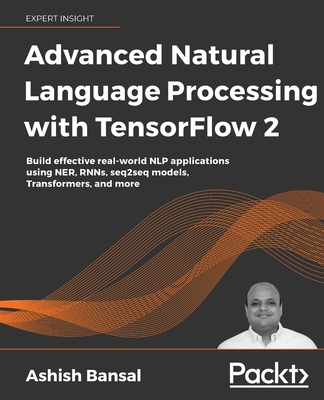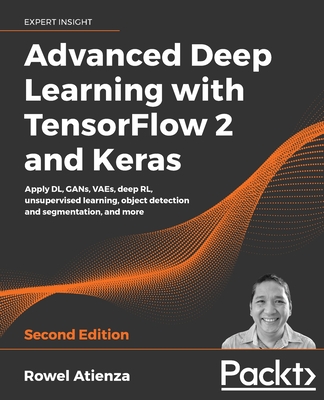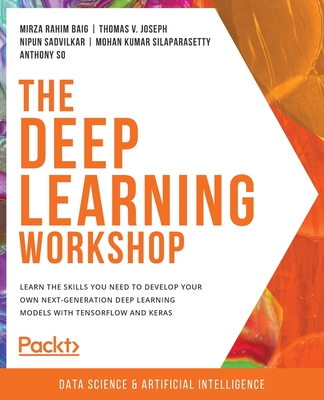Advanced Deep Learning with TensorFlow 2 and Keras - Second Edition
暫譯: 進階深度學習:使用 TensorFlow 2 和 Keras(第二版)
Atienza, Rowel
- 出版商: Packt Publishing
- 出版日期: 2020-02-28
- 售價: $1,500
- 貴賓價: 9.5 折 $1,425
- 語言: 英文
- 頁數: 512
- 裝訂: Quality Paper - also called trade paper
- ISBN: 1838821651
- ISBN-13: 9781838821654
-
相關分類:
DeepLearning、TensorFlow
立即出貨 (庫存 < 3)
買這商品的人也買了...
-
 Deep Learning (Hardcover)
Deep Learning (Hardcover)$1,650$1,617 -
 Natural Language Processing: Python and NLTK
Natural Language Processing: Python and NLTK$2,900$2,755 -
 Keras Deep Learning Cookbook: Over 30 recipes for implementing deep neural networks in Python
Keras Deep Learning Cookbook: Over 30 recipes for implementing deep neural networks in Python$1,220$1,159 -
 Big Data Analysis with Python (Paperback)
Big Data Analysis with Python (Paperback)$1,320$1,254 -
 Technical Analysis for Dummies
Technical Analysis for Dummies$990$941 -
 Hands-On Computer Vision with Tensorflow 2
Hands-On Computer Vision with Tensorflow 2$1,395$1,325 -
 TensorFlow 與 Keras - Python 深度學習應用實務
TensorFlow 與 Keras - Python 深度學習應用實務$650$553 -
 $602知識圖譜:方法、實踐與應用
$602知識圖譜:方法、實踐與應用 -
 3天搞懂技術分析:看懂走勢、解讀線圖,橫掃股市乘風破浪!
3天搞懂技術分析:看懂走勢、解讀線圖,橫掃股市乘風破浪!$320$272 -
 $1,464Deep Learning with TensorFlow 2 and Keras, 2/e (Paperback)
$1,464Deep Learning with TensorFlow 2 and Keras, 2/e (Paperback) -
 88張圖看懂 技術分析:你也能跟他一樣,10年賺到7000萬!
88張圖看懂 技術分析:你也能跟他一樣,10年賺到7000萬!$300$255 -
 Deep Learning for Beginners
Deep Learning for Beginners$1,650$1,568 -
 Towards Tensorflow 2.0:無痛打造AI模型(iT邦幫忙鐵人賽系列書)
Towards Tensorflow 2.0:無痛打造AI模型(iT邦幫忙鐵人賽系列書)$500$390 -
 Mastering Reinforcement Learning with Python: Build next-generation, self-learning models using reinforcement learning techniques and best practices (Paperback)
Mastering Reinforcement Learning with Python: Build next-generation, self-learning models using reinforcement learning techniques and best practices (Paperback)$1,800$1,710 -
 Advanced Natural Language Processing with TensorFlow 2: Build real-world effective NLP applications using NER, RNNs, seq2seq models, Transformers, and
Advanced Natural Language Processing with TensorFlow 2: Build real-world effective NLP applications using NER, RNNs, seq2seq models, Transformers, and$1,440$1,368 -
 $1,680Practical Deep Learning: A Python-Based Introduction
$1,680Practical Deep Learning: A Python-Based Introduction -
 Developing Graphics Frameworks with Python and OpenGL (Hardcove)
Developing Graphics Frameworks with Python and OpenGL (Hardcove)$4,200$3,990 -
 $2,736Practical Machine Learning for Computer Vision: End-To-End Machine Learning for Images (Paperback)
$2,736Practical Machine Learning for Computer Vision: End-To-End Machine Learning for Images (Paperback) -
 基於 BERT 模型的自然語言處理實戰
基於 BERT 模型的自然語言處理實戰$828$787 -
 $559自然語言處理:基於預訓練模型的方法
$559自然語言處理:基於預訓練模型的方法 -
 Optimizing Visual Studio Code for Python Development: Developing More Efficient and Effective Programs in Python
Optimizing Visual Studio Code for Python Development: Developing More Efficient and Effective Programs in Python$2,350$2,233 -
 Keras 大神歸位:深度學習全面進化!用 Python 實作 CNN、RNN、GRU、LSTM、GAN、VAE、Transformer
Keras 大神歸位:深度學習全面進化!用 Python 實作 CNN、RNN、GRU、LSTM、GAN、VAE、Transformer$1,200$948 -
 Learn Three.js : Program 3D animations and visualizations for the web with JavaScript and WebGL, 4/e (Paperback)
Learn Three.js : Program 3D animations and visualizations for the web with JavaScript and WebGL, 4/e (Paperback)$1,950$1,853 -
 Python + ChatGPT 零基礎 + 高效率學程式設計與運算思維, 3/e
Python + ChatGPT 零基礎 + 高效率學程式設計與運算思維, 3/e$780$616 -
 ChatGPT-4 與 Bing Chat - 創新體驗文字/繪圖/音樂/動畫/影片的AI世界
ChatGPT-4 與 Bing Chat - 創新體驗文字/繪圖/音樂/動畫/影片的AI世界$520$411
商品描述
Advanced Deep Learning with TensorFlow 2 and Keras, Second Edition is a completely updated edition of the bestselling guide to the advanced deep learning techniques available today. Revised for TensorFlow 2.x, this edition introduces you to the practical side of deep learning with new chapters on unsupervised learning using mutual information, object detection (SSD), and semantic segmentation (FCN and PSPNet), further allowing you to create your own cutting-edge AI projects.
Using Keras as an open-source deep learning library, the book features hands-on projects that show you how to create more effective AI with the most up-to-date techniques.
Starting with an overview of multi-layer perceptrons (MLPs), convolutional neural networks (CNNs), and recurrent neural networks (RNNs), the book then introduces more cutting-edge techniques as you explore deep neural network architectures, including ResNet and DenseNet, and how to create autoencoders. You will then learn about GANs, and how they can unlock new levels of AI performance.
Next, you’ll discover how a variational autoencoder (VAE) is implemented, and how GANs and VAEs have the generative power to synthesize data that can be extremely convincing to humans. You'll also learn to implement DRL such as Deep Q-Learning and Policy Gradient Methods, which are critical to many modern results in AI.
商品描述(中文翻譯)
《進階深度學習:使用 TensorFlow 2 和 Keras(第二版)》是一本完全更新的暢銷指南,介紹當前可用的進階深度學習技術。本書針對 TensorFlow 2.x 進行了修訂,並引入了無監督學習(使用互信息)、物體檢測(SSD)和語義分割(FCN 和 PSPNet)等新章節,進一步幫助您創建自己的尖端 AI 專案。
本書使用 Keras 作為開源深度學習庫,包含實作專案,展示如何使用最新技術創建更有效的 AI。
本書首先概述了多層感知器(MLPs)、卷積神經網絡(CNNs)和遞迴神經網絡(RNNs),然後介紹更尖端的技術,探索深度神經網絡架構,包括 ResNet 和 DenseNet,以及如何創建自編碼器。接著,您將學習生成對抗網絡(GANs),以及它們如何解鎖 AI 性能的新層次。
接下來,您將發現變分自編碼器(VAE)的實作方式,以及 GANs 和 VAEs 如何具備生成數據的能力,這些數據對人類來說可能極具說服力。您還將學習實作深度強化學習(DRL),例如深度 Q 學習和策略梯度方法,這些對於許多現代 AI 的成果至關重要。
作者簡介
Rowel Atienza is an Associate Professor at the Electrical and Electronics Engineering Institute of the University of the Philippines, Diliman. He holds the Dado and Maria Banatao Institute Professorial Chair in Artificial Intelligence and received his MEng from the National University of Singapore for his work on an AI-enhanced four-legged robot. He finished his Ph.D. at The Australian National University for his contribution in the field of active gaze tracking for human-robot interaction. His current research work focuses on AI and computer vision.
作者簡介(中文翻譯)
Rowel Atienza 是菲律賓大學迪利曼校區電機與電子工程學院的副教授。他擔任 Dado 和 Maria Banatao 人工智慧研究所教授職位,並因其在人工智慧增強的四足機器人方面的研究獲得新加坡國立大學的碩士學位。他在澳洲國立大學完成博士學位,專注於人機互動中的主動注視追蹤技術。他目前的研究工作集中在人工智慧和計算機視覺領域。






























